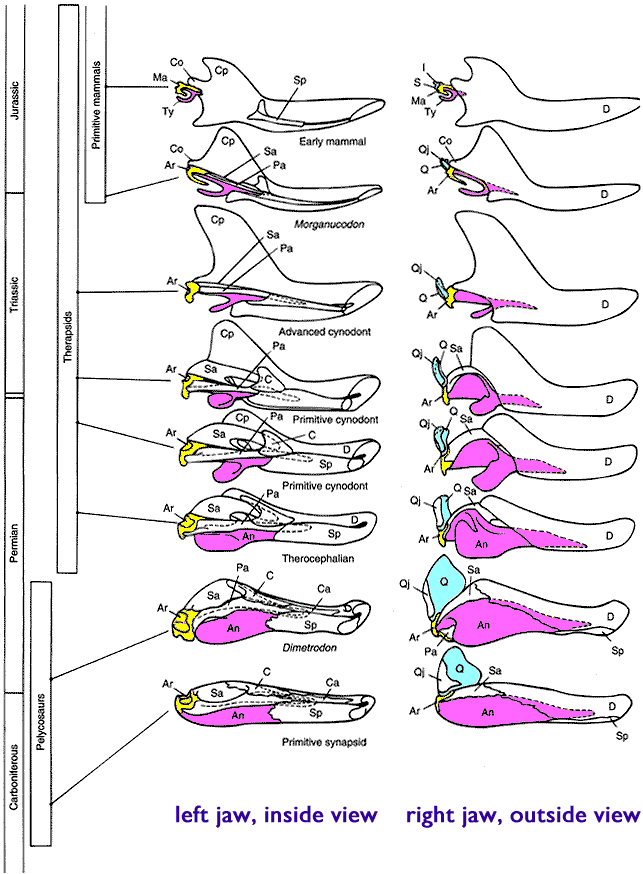It is Mann's blog I will be responding to yet again, as he recently wrote a post titled Commonalities Fail to Prove Common Descent. I originally intended to respond on his blog, but the format is awkward and word limits prevent one from being able to say much. He also censors comments on his blog, so this seems like the best option.
Some creationists are more of a challenge than Mann, see here, here and here for my exchanges with one such example. I don't expect Daniel to pay any attention to this, but it is here nonetheless. I should also not make comments about his character, but Mann has openly admitted that he lacks scientific understanding, yet he happily turns around and declares that the majority of biologists are wrong. His sort need to be kept quiet through education.
Commonalities Fail to Prove Common Descent?
When I first started reading his blog post, I expected to just ignore it, but he mentioned palaeontology and I felt the urge to write this. He states "They attempted to [prove evolution] with the fossil record. However, this record has stubbornly resisted efforts to conform it to evolutionary orthodoxy." This, to me, quite clearly shows that he is at least twenty years behind modern palaeontology. The rise of palaeobiology in the 70s sparked a lot of debate about the relationship between palaeontology and evolution, a debate which creationists have twisted horrifically. That debate raged for a decade or so and eventually evolutionary biologists started to really get their heads around what the fossil record really showed with regards to evolution. For the past twenty years, transitional fossils in particular have been cropping up near constantly (especially since China opened up to collection).
Mann then goes on to quote Stephen Jay Gould, using a quotation which I am sure he has been corrected on before as it is a blatant quote mine:
“The extreme rarity of transitional forms in the fossil record persists as a trade secret of palaeontology…The history of most fossil species includes two features particularly inconsistent with the idea that they gradually evolved:
1. Stasis. Most species exhibit no directional change during their tenure on earth. They appear in the fossil record looking pretty much the same as when they disappear…
2. Sudden appearance. In any local area a species does not arise gradually by the steady transformation of its ancestors; it appears all at once and ‘fully formed.’”
One of the first things to note is the age of the quotation. Gould has actually been dead for nearly ten years now, but these words of his are much older than that. Considering how much palaeontology has progressed in the last few decades, this quotation is clearly out of date. It must also be noted what Gould is talking about, as he is addressing the rarity of transitional forms at the species level, as this change happens too rapidly to be recorded geologically. However, there are some examples which even Gould and Eldredge acknowledged. Additionally, Gould wrote often about transitional forms above the species level. This quotation does not support Mann's claims at all. For a bit more detail on Gould's views, I wrote this piece about punctuated equilibria a few years ago, in which some examples of microevolution are acknowledged.
 |
| The beautiful mammalian jaw/inner ear bone transition. |
He then quotes Mark Ridley in a quotation from 1981:
"No real evolutionist…uses the fossil record as evidence in favor of the theory of evolution as opposed to special creation."
Again, this is outdated, and again, it is out of context. Ridley goes on to explain the evidence which is used for evolution and even that is outdated, as he makes no real reference to the genetic data which has also become voluminous over the past couple of decades. Mann has often been accused of quote mining, even though he is simply parroting the quote mines of others, but he should surely have realised by now that it would make sense to check his sources to make sure they are saying what he thinks they are saying.
He then quotes Gareth Nelson, in what is probably his worst misunderstanding:
"It is a mistake to believe that even one fossil species… can be demonstrated to have been ancestral to another."
I wholeheartedly agree. Nelson's point is that we have no way to test and confirm whether one fossil species was ancestral to another, but his point is not that we cannot confirm whether or not they were related. Palaeontologists these days are aware that claiming an ancestral relationship in the vast majority of cases is not scientific. Instead, you will find them pointing out that they possessed a transitional morphology and were closely related to other such forms.
Convergence is a problem for evolution??
 |
| Convergence between placentals and marsupials. Note that the convergences are functional. |
In his post, Mann considers these to be nails in the coffin of common descent. Clearly he has not achieved this, but either way he declares that "[biologists] have sought out commonalities in other areas to support their belief in common descent."
Mann's chosen example is an interesting one, as it allows us to explore evolution a little and was also something I had not looked into. Instead of addressing the most common lines of evidence, such as the abundant genetic data, he focusses on a morphological similarity and makes some arguments which appear to be becoming more common amongst anti-evolutionists. His chosen example is bioluminescence, but it is his how he uses it which interests me.
The science deniers are becoming increasingly fascinated with convergent evolution. But unlike convergence enthusiast Simon Conway Morris, their fascination comes from an attempt to disprove evolution. It basically boils down to "oh look, evolutionists said similarities prove evolution, now they are saying that similarities can occur without them being closely related". There is a huge oversight going on here. Some of the best evidence for evolution comes from non-function, such as pseudogenes and retrotransposons in the genome. Instead, the commonalities Mann wants to look at are functional.
Convergent evolution occurs when function is similar or the same. Some problems have limited solutions and so we can expect that natural selection will lead to some traits occurring multiple times independently. Often the convergence is imperfect, or will have a different genetic substrate, but occasionally convergence appears to be perfect on all levels. Nature is constrained in the possible solutions available, so convergence is inevitable.
Hydrodynamic form is an excellent example, because there are very few ways in which a body can be streamlined in water. The torpedo shape is an obvious one for travelling at speed, so animals adapting to that lifestyle would be likely to stumble upon that form. That's why we can see the same basic body shape in sharks, ichthyosaurs and dolphins. When we look at them closely, we start to see some key differences, with one obvious one being how they actually move through the water. The up-down motion of the dolphin tail fluke gives away their mammalian ancestry. For my longer argument on that, see here: http://palaeobabbler.blogspot.com/2010/08/whats-that-swimming-toward-me.html
A very brief look at phylogenetics
When plotting evolutionary family trees (phylogenies) there are certain characters which need to be taken into account and there are some problems to overcome. The terms used here are synapomorphies, plesiomorphies, and homoplasy. I'll briefly look at these.
Synapomorphies: These are the derived traits, the ones which define a group. They are shared by taxa with a common ancestor which also has that trait, but whose ancestor does not have that trait. For example, feathers in birds and theropods are a synapomorphy which is shared by all in this group. Synapomorphies must be distinguished from plesiomorphies in order for cladistics to work.
Plesiomorphies: These are ancestral traits, shared by the taxa but going back to a further common ancestor. One such character for birds would be their erect gait, which is found in dinosaurs which do not belong to Theropoda. It therefore cannot be used as a defining feature of birds, as their non-avian ancestors possessed it too.
Homoplasy: This is perhaps the most frustrating for such analyses. This basically includes any trait which is found in distantly related species but is, as Mann would call it, a "commonality". This includes convergent evolution, parallel evolution, and mimicry. Continuing the bird example, birds are warm blooded and so are mammals, but this evolved independently. These traits cannot be used for establishing phylogeny, though it is usually possibly to establish convergence as an explanation.
For more on convergent evolution, check out the Map of Life website for some amazing examples and explanations: http://www.mapoflife.org/ It is based on the work of Simon Conway Morris, who sees convergence as pointing towards God (so Christians need not think of him as having an atheistic agenda, as they are wont to do).
Biologists do not carelessly write off such similarities as convergent evolution, not without justification. Convergence is rarely precise and so can be quite obvious. Going back to dolphins and sharks, it is clear that their shape is dictated by natural constraints, so when we look at their other features it is clear that their ancestry is different. Dolphins are clearly mammals, not least due to their possession of mammary glands. The simple ability to nest dolphins within mammalia should show that convergent evolution is not just possible, but to be expected.
I will not comment on Mann's bio-luminescence example. I know little with regards to that specific adaptation and would not like to speak ignorantly. Convergent evolution, however, needs to be properly understood in order to criticise it, and no creationist seems to want to do the legwork.
Biologists do not carelessly write off such similarities as convergent evolution, not without justification. Convergence is rarely precise and so can be quite obvious. Going back to dolphins and sharks, it is clear that their shape is dictated by natural constraints, so when we look at their other features it is clear that their ancestry is different. Dolphins are clearly mammals, not least due to their possession of mammary glands. The simple ability to nest dolphins within mammalia should show that convergent evolution is not just possible, but to be expected.
I will not comment on Mann's bio-luminescence example. I know little with regards to that specific adaptation and would not like to speak ignorantly. Convergent evolution, however, needs to be properly understood in order to criticise it, and no creationist seems to want to do the legwork.





No comments:
Post a Comment